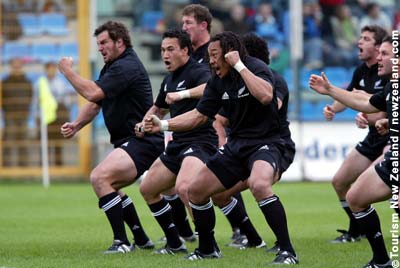Violent foot-stamping, lizard-like tongue protrusions and rhythmic body slapping – so heavy it induces a bright red skin glow – are just one side of kapa haka performances.
While those actions might appear aggressive, kapa haka – the traditional performance art of New Zealand’s Māori people – is equally about grace, elegance and stylistic movement.

Powerful art form
It is the ability to convey a vast range of feelings and emotions that make kapa haka such a powerful art form.
At one moment a softly sung choral arrangement enhanced by the synchronised dance of the women’s poi, a kapa haka performance can suddenly break into a ferocious war chant, growls and blood curdling screams.
This haka or war dance is an unrestrained display of anger and aggression used in ancestral times to mentally prepare war parties readying themselves for battle.
Origins of kapa haka
The origins of kapa haka lie in Hawaiki, ancient home of the Māori.
Legend tells how a troupe of women was sent by the ancestor Tinirau to identify and capture Kae. This Kae had killed and eaten Tinirau’s pet whale – Tutunui – but the only description the group had of Kae was his hideous, overlapping teeth.
When the women arrived at the village of Kae, they quickly devised a cunning plan to make the audience laugh. They began to sing, accompanying their comical tune with curious facial expressions and vigorous movement of the arms and legs.
By the end of the performance, the whole village was laughing so uncontrollably that Kae was easily identified and apprehended.
Kapa haka performances
The power of kapa haka to make people smile has not diminished through the ages, and the art form is alive and well in modern Māori society.
As well as performances for ceremonial and competitive purposes, kapa haka has long been used to entertain international visitors.
There are many opportunities for visitors to New Zealand to experience kapa haka in authentic surroundings including:
- Te Puia, Rotorua
At Rotorua, the birthplace of Māori cultural tourism, tourists flock to Te Puia Māori Arts and Crafts Centre to immerse themselves in Māori culture and custom. The Te Puia experience includes a traditional welcome onto a marae (Māori meeting house) for a kapa haka performance, and a dinner of traditional and contemporary indigenous Māori food. Te Puia is located in the Whakarewarewa valley on the edge of Rotorua, in the heart of Rotorua’s thermal wonderland. - Wairakei Terraces, Taupo
At Lake Taupo, Wairakei Terraces offer an authentic kapa haka experience that begins with a wero (traditional Māori challenge) before visitors are welcomed onto the marae for an intimate performance by the local Tuwharetoa people. - Willowbank Wildlife Reserve, Christchurch
Ko Tāne, in Christchurch’s Willowbank Wildlife Reserve, is a kapa haka experience set in a replicated pā (ancient Māori village). The chants, songs and haka of the performance are enhanced by occasional calls of kiwi and other native birds.
Kapa haka competitions
Besides providing an authentic cultural experience, kapa haka also has a competitive side that is the backbone of the art form in modern times. Kapa haka competitions are held at all levels, from pre-schoolers to kaumātua (elders) and are always fiercely contested.
Every two years, the premier kapa haka groups from around the country come together to battle for the title of national kapa haka champion. This festival is known as Te Matatini (the many faces), a name that reflects the diversity of those who attend.
All Blacks haka
Read more: The history of ‘haka’ and the All Blacks rugby team of New Zealand

